Verbs are an essential part of speech in English grammar. They are words that express action or a state of being. Verbs can be classified into intransitive and transitive verbs based on their usage in a sentence.
Intransitive verbs do not require an object to complete their meaning. They are verbs that express action or describe a state of being without the need for a direct object. On the other hand, transitive verbs require a direct object to complete their meaning. They are verbs that act upon a direct object in a sentence.
Examples of Intransitive and Transitive Verbs
Here are some examples of intransitive verbs:
- She sleeps.
- The birds fly.
- The sun rises.
In these sentences, the verbs “sleeps,” “fly,” and “rises” do not require a direct object to complete their meaning. They express action or a state of being without acting upon an object.
On the other hand, here are some examples of transitive verbs:
- She eats an apple.
- He reads a book.
- We painted the wall.
In these sentences, the verbs “eats,” “reads,” and “painted” require a direct object (an apple, a book, and the wall) to complete their meaning. They act upon the object to express the action performed.
It is important to note that some verbs can be both intransitive and transitive, depending on how they are used in a sentence. For example:
- The door opened. (intransitive)
- She opened the door. (transitive)
In the first sentence, “opened” is an intransitive verb as it does not require a direct object. In the second sentence, “opened” is a transitive verb as it acts upon the direct object “the door.”
In conclusion, understanding the difference between intransitive and transitive verbs is essential for constructing grammatically correct sentences. Intransitive verbs do not require a direct object, while transitive verbs do. By recognizing and using these verbs correctly, you can improve the clarity and accuracy of your writing.
